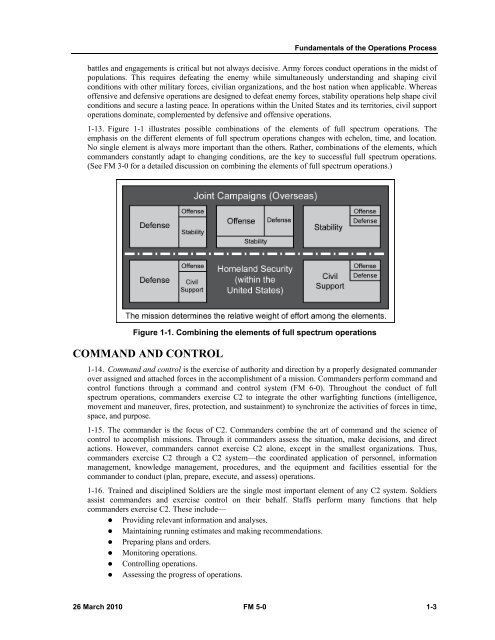FM 5-0, The Operations Process - Federation of American Scientists
FM 5-0, The Operations Process - Federation of American Scientists
FM 5-0, The Operations Process - Federation of American Scientists
You also want an ePaper? Increase the reach of your titles
YUMPU automatically turns print PDFs into web optimized ePapers that Google loves.
Fundamentals <strong>of</strong> the <strong>Operations</strong> <strong>Process</strong><br />
battles and engagements is critical but not always decisive. Army forces conduct operations in the midst <strong>of</strong><br />
populations. This requires defeating the enemy while simultaneously understanding and shaping civil<br />
conditions with other military forces, civilian organizations, and the host nation when applicable. Whereas<br />
<strong>of</strong>fensive and defensive operations are designed to defeat enemy forces, stability operations help shape civil<br />
conditions and secure a lasting peace. In operations within the United States and its territories, civil support<br />
operations dominate, complemented by defensive and <strong>of</strong>fensive operations.<br />
1-13. Figure 1-1 illustrates possible combinations <strong>of</strong> the elements <strong>of</strong> full spectrum operations. <strong>The</strong><br />
emphasis on the different elements <strong>of</strong> full spectrum operations changes with echelon, time, and location.<br />
No single element is always more important than the others. Rather, combinations <strong>of</strong> the elements, which<br />
commanders constantly adapt to changing conditions, are the key to successful full spectrum operations.<br />
(See <strong>FM</strong> 3-0 for a detailed discussion on combining the elements <strong>of</strong> full spectrum operations.)<br />
Figure 1-1. Combining the elements <strong>of</strong> full spectrum operations<br />
COMMAND AND CONTROL<br />
1-14. Command and control is the exercise <strong>of</strong> authority and direction by a properly designated commander<br />
over assigned and attached forces in the accomplishment <strong>of</strong> a mission. Commanders perform command and<br />
control functions through a command and control system (<strong>FM</strong> 6-0). Throughout the conduct <strong>of</strong> full<br />
spectrum operations, commanders exercise C2 to integrate the other warfighting functions (intelligence,<br />
movement and maneuver, fires, protection, and sustainment) to synchronize the activities <strong>of</strong> forces in time,<br />
space, and purpose.<br />
1-15. <strong>The</strong> commander is the focus <strong>of</strong> C2. Commanders combine the art <strong>of</strong> command and the science <strong>of</strong><br />
control to accomplish missions. Through it commanders assess the situation, make decisions, and direct<br />
actions. However, commanders cannot exercise C2 alone, except in the smallest organizations. Thus,<br />
commanders exercise C2 through a C2 system—the coordinated application <strong>of</strong> personnel, information<br />
management, knowledge management, procedures, and the equipment and facilities essential for the<br />
commander to conduct (plan, prepare, execute, and assess) operations.<br />
1-16. Trained and disciplined Soldiers are the single most important element <strong>of</strong> any C2 system. Soldiers<br />
assist commanders and exercise control on their behalf. Staffs perform many functions that help<br />
commanders exercise C2. <strong>The</strong>se include—<br />
• Providing relevant information and analyses.<br />
• Maintaining running estimates and making recommendations.<br />
• Preparing plans and orders.<br />
• Monitoring operations.<br />
• Controlling operations.<br />
• Assessing the progress <strong>of</strong> operations.<br />
26 March 2010 <strong>FM</strong> 5-0 1-3















